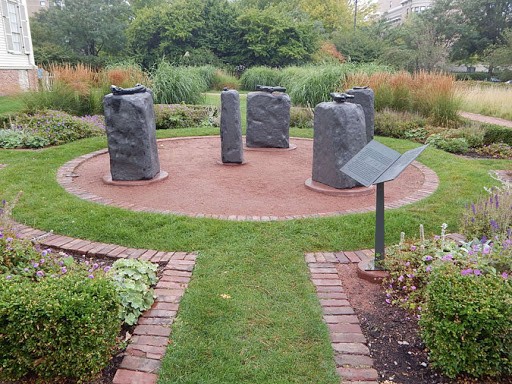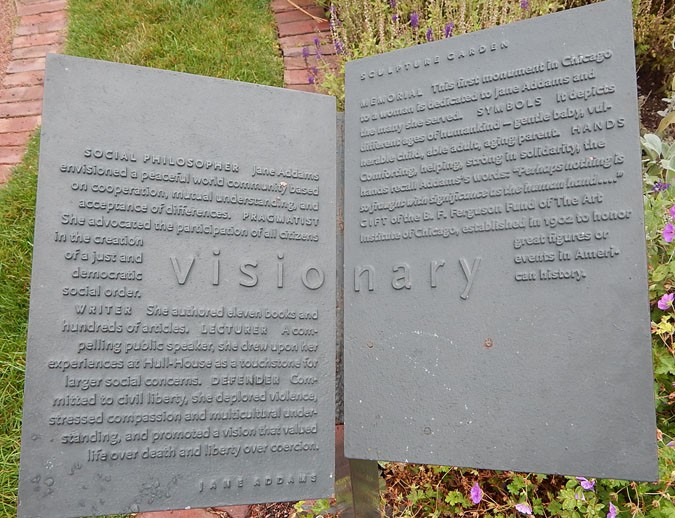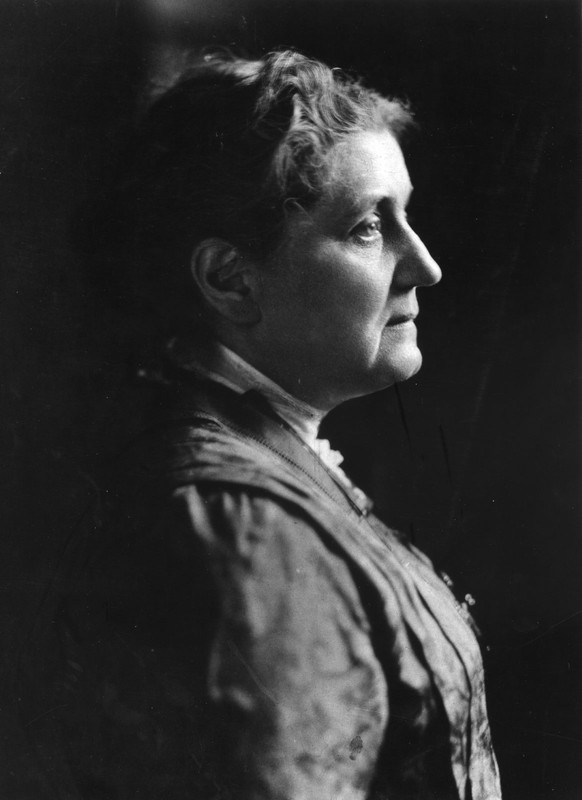Helping Hands: Memorial to Jane Addams
Introduction
Text-to-speech Audio
Images
Helping Hands: Memorial to Jane Addams

A closer look at some of the carved Black granite hands

Informational plaque near the memorial that summarizes Addams's life and contributions

Jane Addams (1860-1935)

Backstory and Context
Text-to-speech Audio
Jane Addams was born into a family of privilege on September 6, 1860 in Cedarville, Illinois. Her father, John Huy Addams, was a successful mill owner and member of the Illinois State Senate. In January 1863, when she was two years old, her mother, Sarah (Weber) Addams, died in childbirth, leaving her to be raised primarily by her older sisters. After graduating at the top of her class from Rockford Female Seminary in 1881, Addams briefly attended the Women’s Medical College of Philadelphia, but serious health problems made her an invalid for two years and prevented her from completing her studies. From 1883 to 1885, she traveled across Europe and, upon her return to the United States, lived in Baltimore until 1887.
On a return trip to Europe with friend and Rockford classmate, Ellen Gates Starr, Addams discovered her calling in life. While staying in London in 1888, the two women visited Toynbee Hall, a settlement house in the city’s working-class East End. Seeing the potential value of settlement houses in America’s industrial cities, Addams and Starr decided to open one upon returning to the United States. In 1889, they purchased a large vacant residence in Chicago’s West Side, a neighborhood inhabited predominantly by poor and working-class immigrants. Since it was built by a man named Charles Hull in 1856, Addams and Starr called it Hull-House. One of the first settlement houses in North America, it offered a wide range of services, including childcare for working parents and English classes for immigrants. Providing young, educated, reform-minded women the opportunity to acquire valuable experience and training, Hull-House attracted the likes of Julia Lathrop, Florence Kelley, and Frances Perkins.
After founding Hull-House, Addams worked tirelessly to enact child labor laws, secure suffrage for women, address racial injustice, and promote international peace. In 1907, she helped establish the National Child Labor Committee, which influenced the passage of the Keating-Owen Child Labor Act of 1916. Addams also served as an officer in the National American Women’s Suffrage Association and helped to found the National Association for the Advancement of Colored People (NAACP). A pacifist, she toured the belligerent nations with a group of female peace activists after the outbreak of the Great War in the hope of bringing about a cessation of hostilities. Addams led the Women’s Peace Party in 1915 and soon after became president of the International Congress of Women. In 1917, she protested America’s entry into the conflict. After the war, Addams helped to found the Women’s International League for Peace and Freedom in 1919 and served as its president until 1929. Two years later, she became the first American woman to be awarded the Noble Peace Prize. Addams died in Chicago on May 21, 1935.
Several decades after Addams’s death, the Ferguson Fund of the Art Institute of Chicago commissioned esteemed French-born sculptor Louise Bourgeois to design a memorial in honor of the social reformer and Noble Peace Prize winner. The result was Helping Hands, a series of carved Black granite human hands atop six roughly-hewn stone pedestals. The hands are of all ages, backgrounds, and ethnicities, and symbolize the wide range of people whose lives Addams helped to improve. Dedicated on Women’s Equality Day (August 26) in 1996, the memorial originally stood along Chicago’s lakefront in Navy Pier Park. After suffering vandalism, it was removed and sent back to Bourgeois’s studio in New York City for repairs in 2006. The memorial then sat in storage for years before being installed in Chicago Women’s Park in 2011. It is the first major artwork in a Chicago public park to honor a woman.
Sources
"Helping Hands." Chicago Park District. City of Chicago. Web. 12 March 2021 <https://www.chicagoparkdistrict.com/parks-facilities/helping-hands>.
"Jane Addams." Encyclopædia Britannica. 3 February 2021. Web. 12 March 2021 <https://www.britannica.com/biography/Jane-Addams>.
Michals, Debra. "Jane Addams." National Women's History Museum. 2017. Web. 12 March 2021 <https://www.womenshistory.org/education-resources/biographies/jane-addams>.
http://www.sanantoniopeace.center/mondays-monument-helping-hands-jane-addams-memorial-chicago-illinois/
http://www.sanantoniopeace.center/mondays-monument-helping-hands-jane-addams-memorial-chicago-illinois/
https://www.glessnerhouse.org/story-of-a-house/2015/08/helping-hands-that-talk.html
https://www.britannica.com/biography/Jane-Addams
